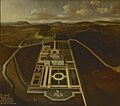Humphrey Coningsby (judge) facts for kids
Quick facts for kids
Sir Humphrey Coningsby
|
|
|---|---|
| Born | 1459 Rock, Worcestershire, England
|
| Died | 2 June 1535 (aged 75–76) England
|
| Occupation | Lawyer, judge |
| Parent(s) | Thomas Coningsby, Catherine Waldiffe |
Sir Humphrey Coningsby (born around 1459 – died 2 June 1535) was an important English lawyer and a senior judge. He was known as a Justice of the King's Bench, which meant he was one of the top judges in the country. He also owned a lot of land.
Contents
Early Life and Family
Humphrey Coningsby was born just before 1460. His parents were Thomas Coningsby and Catherine Waldiffe. He was born in a village called Rock in Worcestershire. His father owned a large family home there called the manor of Bower, which had been in their family for a very long time, since at least 1351.
A Career in Law
Humphrey Coningsby chose to become a lawyer. By 1474, he was working as a lawyer in the Court of Common Pleas, which was one of England's main courts. In 1476, he helped the local sheriff as a Deputy for Worcestershire.
During the 1480s, he held several important roles:
- He was a senior clerk in a court, called a Prothonotary.
- He was a court official who helped judges on their travels, known as a Clerk of Assize.
- He became a senior member of a famous law school, the Inner Temple, where he was called a Bencher.
In 1493, he became a justice of the peace for Hertfordshire, acting as a local judge. He became a very important lawyer, known as a Serjeant-at-Law, in 1495. He even had famous clients like Queen Elizabeth and the Duke of Buckingham.
By 1504, he was also a local judge for Worcestershire. In 1505, he became the King's own lawyer, called a King's Serjeant. On May 21, 1509, he was made a Justice of the King's Bench, a top judge for the King. King Henry VIII made him a knight that same year. Sir Humphrey held his position as a judge until November 28, 1533.
Owning Land and Building Churches
While working as a lawyer and judge, Sir Humphrey also actively bought many country estates. Around 1485, he bought Penne's Place in Aldenham, Hertfordshire. This property stayed in his family until 1651. He also bought another manor in Aldenham called Pigott's.
In June 1488, he and his first wife, Isabel, bought the manor of North Piddle in Worcestershire. This property also stayed in the family for a long time, until 1654. At the same time, he bought the manor of Stottesdon in Shropshire.
He continued to buy more land between 1496 and 1514. In 1506, he bought the manor of Orleton in Worcestershire, which his family later sold in 1658.
By 1509, Sir Humphrey had inherited his father's estate at Rock. He made significant improvements to the village church there. He built the south chapel, the south aisle, and the west tower. A window in the church once showed him and his family in special robes.
In 1510, he started a special chapel in the church called the chantry of Our Blessed Lady and St George. He gave land to support a priest who would say mass and run a free grammar school. This school was set up in 1513. He also added more land to his family's property in Rock by buying the manor of Cheney Moor in 1528.
Around 1510, he acquired the large estate of Hampton Court in Herefordshire. This important estate went to his grandson, Humphrey, and remained in the family for nearly 300 years.
Death and Lasting Legacy
Sir Humphrey Coningsby passed away on June 2, 1535. His will, which is a legal document about what happens to his property after his death, was approved on November 26, 1535.
In his will, he left money from his lands in Aldenham to pay for a priest to say mass for his soul in the chapel of Our Lady at the local church for 21 years. He also planned to extend the chapel, but this was never completed.
Earlier, he had founded a chapel called St Mary the Virgin and St George the Martyr at Copthorne Hill in Aldenham. This chapel was allowed to hold services in 1520. However, it was later destroyed in 1547 due to a new law.
In his home village of Rock, his will gave instructions for a special statue of Our Lady in the south aisle to be painted and decorated. He also wanted a statue of St George to be painted and a statue of St Margaret in the Lady Chapel to be fixed.
Family Life
Sir Humphrey Coningsby was married three times. He had sons only from his first marriage.
His first marriage was in the 1480s to Isabel Fereby. His second marriage, around 1499, was to Alice Francis. His third marriage, in 1504, was to Anne Moresby.
His sons, all from his first marriage, were:
- Thomas Coningsby, who had a son named Humphrey Coningsby and a grandson named Sir Thomas Coningsby.
- William Coningsby, who also became a Justice of the King's Bench, like his father.
- John Coningsby, who was the father of Sir Henry Coningsby (died 1590).
His daughters were:
- Elizabeth Coningsby, who married Richard Berkeley and later Sir John FitzJames, who was also a very important judge.
- Amphelisia Coningsby.
- Margaret Coningsby.
- Jane Coningsby.
Images for kids





